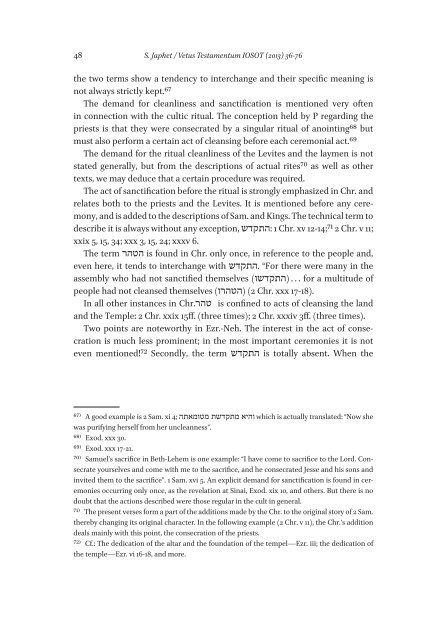Special Issue IOSOT 2013 - Books and Journals
Special Issue IOSOT 2013 - Books and Journals
Special Issue IOSOT 2013 - Books and Journals
You also want an ePaper? Increase the reach of your titles
YUMPU automatically turns print PDFs into web optimized ePapers that Google loves.
48 S. Japhet / Vetus Testamentum <strong>IOSOT</strong> (<strong>2013</strong>) 36-76<br />
the two terms show a tendency to interchange <strong>and</strong> their specific meaning is<br />
not always strictly kept.67<br />
The dem<strong>and</strong> for cleanliness <strong>and</strong> sanctification is mentioned very often<br />
in connection with the cultic ritual. The conception held by P regarding the<br />
priests is that they were consecrated by a singular ritual of anointing68 but<br />
must also perform a certain act of cleansing before each ceremonial act.69<br />
The dem<strong>and</strong> for the ritual cleanliness of the Levites <strong>and</strong> the laymen is not<br />
stated generally, but from the descriptions of actual rites70 as well as other<br />
texts, we may deduce that a certain procedure was required.<br />
The act of sanctification before the ritual is strongly emphasized in Chr. <strong>and</strong><br />
relates both to the priests <strong>and</strong> the Levites. It is mentioned before any ceremony,<br />
<strong>and</strong> is added to the descriptions of Sam. <strong>and</strong> Kings. The technical term to<br />
describe it is always without any exception, :התקדש 1 Chr. xv 12-14;71 2 Chr. v 11;<br />
xxix 5, 15, 34; xxx 3, 15, 24; xxxv 6.<br />
The term הטהר is found in Chr. only once, in reference to the people <strong>and</strong>,<br />
even here, it tends to interchange with .התקדש “For there were many in the<br />
assembly who had not sanctified themselves (התקדשו) . . . for a multitude of<br />
people had not cleansed themselves (הטהרו) (2 Chr. xxx 17-18).<br />
In all other instances in טהר.Chr is confined to acts of cleansing the l<strong>and</strong><br />
<strong>and</strong> the Temple: 2 Chr. xxix 15ff. (three times); 2 Chr. xxxiv 3ff. (three times).<br />
Two points are noteworthy in Ezr.-Neh. The interest in the act of consecration<br />
is much less prominent; in the most important ceremonies it is not<br />
even mentioned!72 Secondly, the term התקדש is totally absent. When the<br />
67) A good example is 2 Sam. xi 4; והיא מתקדשת מטומאתה which is actually translated: “Now she<br />
was purifying herself from her uncleanness”.<br />
68) Exod. xxx 30.<br />
69) Exod. xxx 17-21.<br />
70) Samuel’s sacrifice in Beth-Lehem is one example: “I have come to sacrifice to the Lord. Consecrate<br />
yourselves <strong>and</strong> come with me to the sacrifice, <strong>and</strong> he consecrated Jesse <strong>and</strong> his sons <strong>and</strong><br />
invited them to the sacrifice”. 1 Sam. xvi 5. An explicit dem<strong>and</strong> for sanctification is found in ceremonies<br />
occurring only once, as the revelation at Sinai, Exod. xix 10, <strong>and</strong> others. But there is no<br />
doubt that the actions described were those regular in the cult in general.<br />
71) The present verses form a part of the additions made by the Chr. to the original story of 2 Sam.<br />
thereby changing its original character. In the following example (2 Chr. v 11), the Chr.’s addition<br />
deals mainly with this point, the consecration of the priests.<br />
72) Cf.: The dedication of the altar <strong>and</strong> the foundation of the tempel—Ezr. iii; the dedication of<br />
the temple—Ezr. vi 16-18, <strong>and</strong> more.








![Am HaSefer [Volk des Buches] - Books and Journals](https://img.yumpu.com/20648352/1/174x260/am-hasefer-volk-des-buches-books-and-journals.jpg?quality=85)







